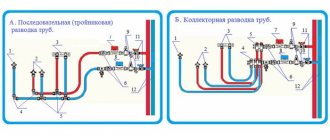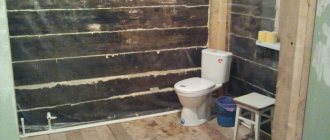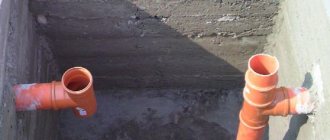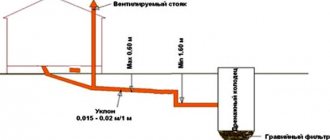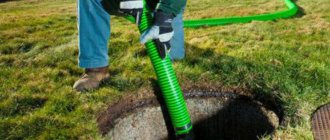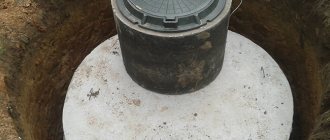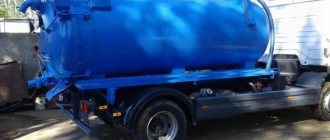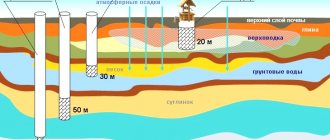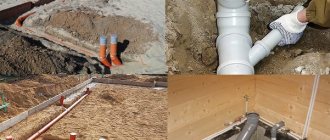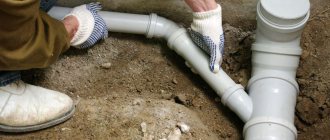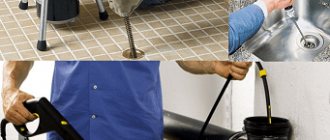Have you ever wondered how a sewer system should be installed in a wooden house, as well as how to make it yourself and install all the elements correctly? Then make yourself comfortable about everything in order.
Not all owners of private houses have the opportunity to connect to main sewer lines. We have to solve the issue in other ways and create an autonomous system. Sewerage in a wooden house can have a completely modern look and meet all sanitary requirements. There are ready-made structures that you just need to purchase and install on the site. You can also make the system yourself, and this option is preferred by most residents of rural or country houses. The main condition will be to study the issue and obtain detailed and high-quality information.
Construction of a sewer system in a wooden house
Structurally, the sewage system in a wooden house is a complex of systems that ensure the collection, transportation and storage of wastewater.
The sewer system diagram of a private house includes the following parts:
- Internal sewerage
. This includes all pipelines located within the building and plumbing fixtures. - External sewerage
. The design of the external sewerage system includes external pipelines that transport wastewater to a storage tank and service equipment. - Reservoir for storing and/or processing waste
. There are different options for such devices. A septic tank is most often used, but biological treatment stations and cesspools are also in demand.
cesspool
The simplest storage tank is a cesspool. It's just a well with walls but no bottom. Concrete rings or bricks are used to construct the walls. This is a simple design and does not require cash injections. But there are many more disadvantages of capacity.
Disadvantages of a cesspool:
- It is impossible to properly clean the drains. The waste can end up in the ground and contaminate drinking water sources.
- It will be necessary to make a large hole, since a large amount of waste is discharged.
- The container must be pumped out periodically.
A cesspool is considered an outdated option for collecting wastewater. She doesn't perform her functions well. It can be installed in a summer cottage where people come only on weekends.
Do-it-yourself internal sewerage
First of all, when installing a sewer system, the internal part of the system is laid.
Its elements include:
- sewer risers;
- outlet pipes;
- plumbing fixtures (toilets, sinks, cisterns, etc.);
- drain pipe (sewage outlet that provides ventilation).
A schematic diagram of the internal wiring is shown in the photo.
When arranging internal sewerage, you must use the following principles:
- Before making a sewer system in a wooden house, you need to install pipes to ensure drainage from the plumbing. A 100 mm pipe is usually installed under the toilet, which is due to the presence of large waste fractions. For other plumbing fixtures, pipes with a diameter of 50 mm are sufficient.
- Each turn of the sewer pipeline must be equipped with an inspection so that, if necessary, the system can be cleaned.
- All drain pipes must ultimately be connected to one riser.
- When choosing pipes for sewerage, you should focus on plastic products. Pipes and shaped elements made of plastic are quite cheap, have excellent performance indicators, so their popularity is growing every day. And assembling a sewer system from plastic pipes is not particularly difficult.
- Installation of sewerage in a wooden house must be done carefully. Wiring is usually installed in ceilings. During installation, care must be taken to ensure that the supporting beams remain undamaged. In addition, when designing a sewer system for a wooden house, it is necessary to take into account the shrinkage of materials. Sewage pumps are also often installed, depending on the need.
- It is best to attach the pipes to a movable joint, otherwise shrinkage of the building will lead to deformation of the sewer system. After the structure is constructed, the pipe joints are sealed and all elements are secured.
Arrangement of wiring from a well
Installing a sewer system from a well is very simple, without spending a lot of money. There are two conditions for wiring. Firstly, the well must have the correct structure: masonry, frame or concrete rings. And secondly, sewers must be insulated. In order to maintain the required water pressure, you need to correctly select and install a fairly powerful pump. You can also install an automatic pumping station. It is better to install pipes for this type of wiring from metal-plastic, which are rust-resistant, elastic and easy to install.
In our company, you can easily purchase all the necessary equipment for wiring the sewerage and water supply systems. Our specialists will help you select it, and will also make a wiring design, carry out all the necessary measurements, and calculate the costs. We will also install a water supply system in a short time, and will certainly provide guarantees for operation.
External system
When laying an external system, it is necessary to create a high-quality pipeline connecting the residential building and the wastewater storage device.
Do-it-yourself external sewerage in a wooden house is assembled using the following algorithm:
- The first step is to prepare the trench in which the pipeline will be laid. The depth of the trench depends on the depth of soil freezing in the region.
- If pipes are located at a depth of less than 0.7 m, they will have to be insulated to prevent them from freezing at subzero temperatures.
- The system must be installed on a slope, which ensures normal movement of waste by gravity.
- The bottom of the trench is concreted or reinforced, increasing the rigidity of the entire highway.
- The length of the main pipeline is determined by an individual project, the calculation of which must be based on building rules and regulations. The plan and design of the sewer system in a private house must be carried out in advance. Installing the system too close to the house will have an unpleasant effect on the comfort and quality of the soil, and if you install the system far away, it will be very ineffective from an economic point of view.
- At the end point, the external sewerage pipeline is connected to a tank for storing and/or processing wastewater.
Septic tank installation
A septic tank is a tank divided into several sections. Usually there are 2 or 3, but more can be used. The wastewater enters the first chamber, settles, and enters the second section through the overflow hole. As it is filled, partially clarified water flows into the next container - and so on. The last overflow connects the septic tank to the filtration well.
The septic tank is installed so that the inlet is at the required height. It is necessary to calculate the length of the pipes and calculate the height difference that forms the given slope. Then the depth of the socket is calculated so that the inlet hole is at the desired level and connected to the end of the pipe. After connecting the sinuses, the nests are covered with soil and carefully compacted, ensuring the immobility of the tank.
How to insulate sewer pipes
Sewer pipes must be insulated in almost all cases.
Such an investment will pay off in any case, even at the stage of laying the pipeline: the depth of the trench in this case can be reduced. There are three basic schemes for pipe insulation:
- Natural.
- Using thermal insulation materials.
- Using electric heating.
The natural heating method is the simplest.
To implement it, it is enough to bury the pipes at a great depth so that the layer of soil located above the pipeline protects it from exposure to low temperatures. This method is well suited for warm regions, but in colder conditions you will have to use others. The most common and effective way to insulate pipes is to use thermal insulation.
Thermal insulation, in turn, can be used in two ways:
- Rolled
. This method involves wrapping material around a sewer pipe. - Formovym
. For insulation, special molds of the appropriate diameter are used.
In very harsh conditions, when even thermal insulation materials cannot cope with the task, the heating problem can be solved with the help of electric heating. For this, a special cable is used, which is laid along the entire highway. Some models of sewer pipes are made with a cable, which eliminates the need to install it yourself.
Norms for the distance of treatment facilities on the site
According to SNiP, treatment facilities and pits must be located at a considerable distance from the house, water well and other engineering facilities.
- From a residential building - at least 5 m to a septic tank, VOC, cesspool to avoid unpleasant odors entering the room. And also prevent in advance the possible disastrous consequences of the influence of a humid environment on the foundation of the house.
- It is 30-50 m to a water well. Of course, it is very difficult to follow this rule, since the size of the plots is very limited. It is still necessary to remove the septic tank from the water supply system as much as possible, to the extent technically possible.
- To the borders of the neighboring plot - at least 2 m.
- From the collector to plants and trees - the location is 2-4 m if the tree roots are large.
Sewer repair
A self-built sewer system in a wooden house is constantly subject to stress, so various malfunctions or blockages periodically occur in it.
For example, a malfunction of the drain tank is often encountered. This problem can be solved quite easily, and knowledge of the basic principles of the device’s operation is sufficient. There are tanks with water supply from below or from the side. The likelihood of a particular breakdown often depends on this indicator.
The most common malfunctions include the following:
- Water constantly flows into the toilet
. As a rule, to solve this problem it is enough to correct the skewed float. If this does not help, then the leak may be due to a faulty float or drain valve, so these parts must be replaced. - High noise level when draining
. This practically does not happen in tanks with a bottom line, but with a side line it often occurs. To fix the problem, it is necessary to use a muffler, putting it on the fitting, or completely replace the float mechanism. - Trigger malfunction
. To get rid of this problem, you need to change the chain that ensures the connection between the drain mechanism and the button.
With plumbing repairs, everything is more complicated, since the devices are different, and each of them has its own design differences.
Usually the problem can be resolved by following the appropriate steps according to the instructions included with the plumbing fixture. If this does not help, then you can always contact a specialist. Do-it-yourself external sewerage in a wooden house also rarely causes problems.
The only thing worth doing every few years is to change the filter soil near the treatment plant. In addition, you need to monitor the condition of the drive: problems are often identified at the earliest stages. Conclusion
As can be seen from the above, sewerage can be arranged in different ways. Each of them will require special adaptations and an understanding of certain external factors. Now you know how to install a sewer system in a wooden house to provide it with sufficient comfort.
Thank you for reading this article to the end.
has been offering services for the construction of stone and wooden houses for 10 years.
Our customers include the construction of individual private houses and cottage communities that maintain a single architectural style from economy to premium class.
Reducing construction time, reducing costs and improving the quality of construction work are the basic principles of our company.
We are ready to offer:
Source
Materials and tools
- To dig a trench, you will need a small excavator. If there is no possibility of heavy equipment coming in, you will have to take up shovels.
- The pipes need to be cut with something, some people use a grinder with adjustable speed, or you can use a hacksaw with fine teeth.
- Jackhammer, perforator - make holes in the well and foundation of the house.
- Sand or fine ASG for fixing the pipeline in the trench.
- Insulation, thermal insulation in places where laying sewerage through an external network to a depth below the soil freezing layer is impossible.
The main segment of the drainage system is the pipe, here are its main options:
- Red PVC is available in various sizes.
- Black polyethylene ones also come in diameters from 50 to 159 mm.
- Ribbed - pragma. The length is 4 and 6 m, the diameter is from 100 mm to 500 mm.
- Gray polypropylene (plastic).

